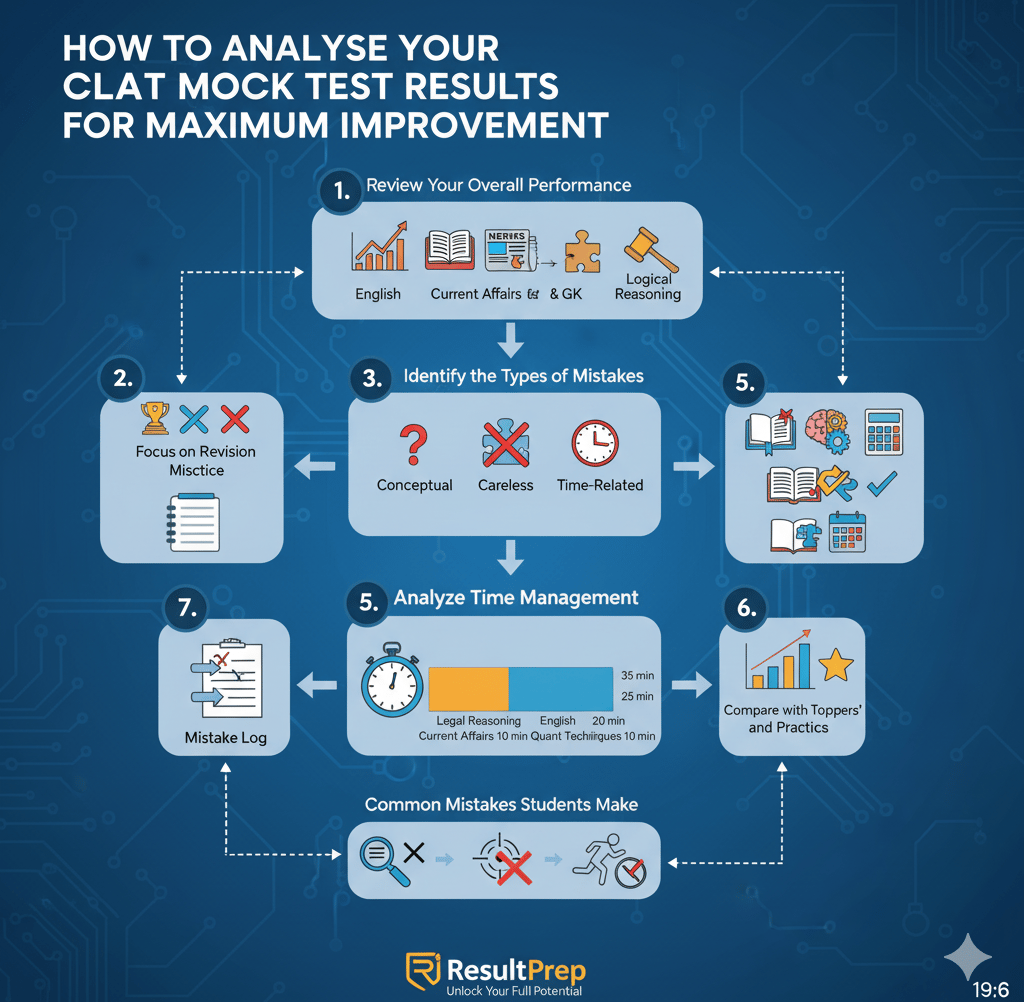Crack CLAT Smarter: Master the Art of Mock Test Analysis
Taking mock tests isn’t enough — analysing them is where real progress happens! 🔍 Learn how to review your CLAT mock results like a topper, identify weak spots, fix time management issues, and turn every mistake into a stepping stone for success. Make every mock count and walk into the exam hall with total confidence! 💪📚
LAW ENTRANCE
10/5/20253 min read


Mock Test: How to Analyse Your CLAT Mock Test Results for Maximum Improvement
Understanding the Importance of Mock Tests
Mock tests are the backbone of any CLAT (Common Law Admission Test) preparation strategy. They simulate the real exam experience, allowing you to assess your readiness, identify weak areas, and improve time management. However, merely attempting mock tests is not enough — what truly matters is how effectively you analyse your CLAT mock test results afterward.
Analysing mock tests helps you understand your mistakes, monitor progress, and build exam temperament. Many toppers credit their success not to the number of mocks they took, but to how well they analysed them.
Step 1: Review Your Overall Performance
After completing a mock test, start by looking at your total score, accuracy rate, and rank (if available). Compare these results with your previous attempts.
Is your overall score improving?
Are you consistently performing better in certain sections?
Are there patterns in your mistakes?
This overview helps you see where you stand and what kind of improvement curve you’re following.
A good benchmark: If you can maintain 80% accuracy with full attempts, you’re on the right track.
Step 2: Section-Wise Analysis
CLAT is divided into five main sections: English Language, Current Affairs including GK, Legal Reasoning, Logical Reasoning, and Quantitative Techniques. Each section demands a unique approach.
English Language
Check if you’re losing marks due to comprehension errors or vocabulary. Try re-reading the passages and understanding how options were eliminated.
Current Affairs & GK
If you missed questions in GK, note the topics (e.g., international events, government schemes, or sports). Revise from a reliable source and make concise monthly notes.
Legal Reasoning
This section can make or break your CLAT score. Identify whether your errors are conceptual (not understanding principles) or analytical (misinterpreting facts).
Logical Reasoning
See if you’re losing time decoding puzzles or struggling with inference-based questions. Practice reasoning sets regularly to boost accuracy.
Quantitative Techniques
Review the calculations. Were they too slow, or did you make silly mistakes? For numerical errors, recheck your formulas and calculation speed.
Step 3: Identify the Types of Mistakes
Mistakes usually fall into three categories:
Conceptual Errors: You didn’t understand the concept properly. Example — confusing tort with contract in Legal Reasoning.
Careless Errors: Simple calculation or reading mistakes due to overconfidence or rushing.
Time-Related Errors: Running out of time and making guesses toward the end.
Create a small “Mistake Log” after every test, noting down what went wrong and how to avoid it next time.
Step 4: Analyze Time Management
The CLAT exam is all about speed with accuracy. Look at the time spent per section and see if it’s balanced. If Legal Reasoning takes too long, you might need to improve your reading speed or learn better skimming techniques.
A good time division can be:
English Language – 20 minutes
Current Affairs – 10 minutes
Legal Reasoning – 35 minutes
Logical Reasoning – 25 minutes
Quantitative Techniques – 10 minutes
Track how close your mock timings are to this pattern and adjust accordingly.
Step 5: Reattempt the Test
Once you’ve reviewed the solutions, reattempt the same mock test after a few days. You’ll notice an improvement in your approach and recall ability. This reinforces learning and ensures that you don’t repeat mistakes.
Step 6: Compare with Toppers’ Analysis
If the mock test platform provides topper comparisons, use them! See how much time toppers spent per question, which sections they prioritized, and how they managed their accuracy. Learning from their patterns helps you build smarter strategies.
Step 7: Focus on Revision and Practice
Mock test analysis should always end with actionable insights. Don’t just highlight mistakes—work on them.
Revise weak topics from books or notes.
Revisit tricky questions regularly.
Take topic-wise sectional tests for consistency.
The goal isn’t just to score higher in the next mock—it’s to develop exam maturity so that the actual CLAT feels like just another practice test.
Common Mistakes Students Make While Analyzing Mocks
Ignoring easy questions that were answered incorrectly.
Focusing too much on total score instead of accuracy.
Not keeping track of recurring mistake patterns.
Skipping reattempts after reviewing solutions.
Avoid these pitfalls, and your preparation will grow exponentially.
Conclusion: Make Every Mock Count
Mock tests are not merely practice—they are your training ground for success. The more effectively you analyze them, the more refined your strategy becomes. Each test you review brings you one step closer to your dream NLU.
Remember, it’s not about how many mocks you attempt, but how many lessons you extract from each one.
So, open your scorecard, grab your notebook, and start decoding your mistakes today — your CLAT success story starts with smart analysis!
Prepare for the best results!
Achieve your goals with expert coaching and support from ResultPrep.
Contact us:
© 2025. All rights reserved.
Address:
GSS Complex, 2nd Floor,
16th Cross Rd, HMT Layout, Vidyaranyapura, Bengaluru, Karnataka- 560097
